Clients leaving care
On this page
Key findings: Clients exiting care, 2020–21
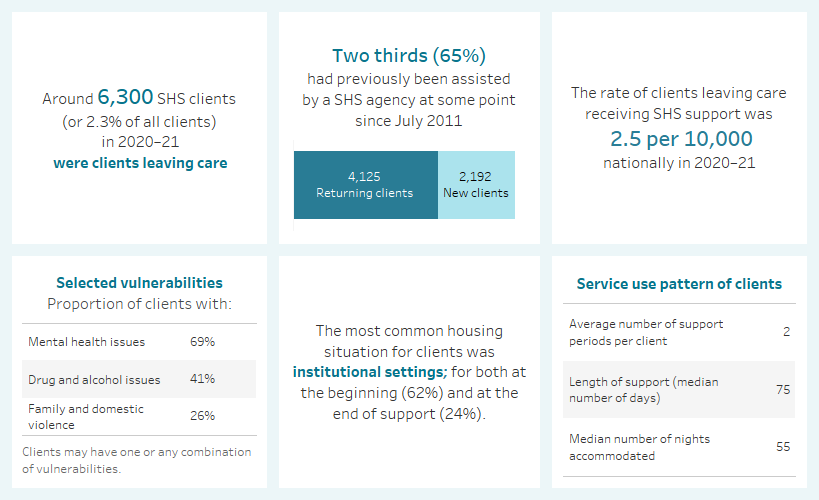
People leaving care arrangements, including people transitioning from health care settings (hospitals, psychiatric hospitals, rehabilitation and aged care facilities) and young people transitioning from out-of-home care (foster care and residential care facilities), can find themselves particularly vulnerable to homelessness. This can be due to inadequate transition planning, undertaking discharge assessments in time or resource-pressured environments and limited options for exit into suitable and secure housing (Brackertz et al. 2018).
People exiting institutions and care into homelessness are a national priority homelessness cohort identified in the National Housing and Homelessness Agreement which came into effect on 1 July 2018 (CRRF 2018) (See Policy section for more information).
In 2018–19, around 3,400 young people aged 15–17 were discharged from out-of-home care in Australia (AIHW 2020), corresponding with the end of formal support in the child protection system. One in 3 young people leaving out-of-home care experience homelessness within 12 months of leaving (McDowall 2009). Young people transitioning from out-of-home care face barriers to accessing the same opportunities as their non-care peers who increasingly rely on parental resources in young adulthood (Wilkins et al. 2019). During this accelerated transition to independence, young people leaving care need adequate support to access safe and stable housing, education, employment, financial security, supportive relationships and networks, and life skills (FaHCSIA 2011).
People transitioning from health care settings are also at risk of being discharged into homelessness. In a study of people who have experienced homelessness, 17% had been admitted to hospital for a mental health diagnosis in the previous 2 years (Wood et al. 2016). Discharge from a psychiatric hospital in particular has been identified as a key pathway into homelessness among people with mental health issues (Nielssen et al. 2018).
Reporting clients leaving care in the Specialist Homelessness Services Collection (SHSC)
In the SHSC, a client is identified as transitioning from care arrangements if, in their first support period during the reporting period, either in the week before or at presentation:
- their dwelling type was hospital (excluding psychiatric), psychiatric hospital or unit, disability support, rehabilitation or aged care facility, or
- they identified transition from foster care/child safety residential placements or transition from other care arrangements as a reason for seeking assistance.
Note that these dwelling types are part of the broad housing situation ‘Institutional settings’, which also includes categories relating to custodial arrangements. See the associated section for information specifically relating to Clients exiting custodial arrangements.
For more information see Technical notes.
In 2020–21 (Supplementary tables LCARE.1 and Historical data table HIST.LCARE):
- SHS agencies assisted over 6,300 clients leaving care, equating to 2.3% of all SHS clients in 2020–21
- there were around 400 fewer SHS clients leaving care compared with 2019–20; the number of SHS clients leaving care has steadily decreased since the peak of around 7,100 clients in 2016–17
- the rate of SHS clients leaving care was 2.5 per 10,000 population, a decrease from 2.9 in 2016–17.
Client characteristics
Figure LCARE.1: Key demographics, SHS clients leaving care, 2020–21
This interactive image describes the characteristics of around 6,300 clients leaving care who received support in 2020–21. Most clients were male, aged 18–44. Around a quarter were Indigenous. Victoria had the greatest number of clients and the Northern Territory had the highest rate of clients per 10,000 population. The majority of clients had previously been assisted by a SHS agency since July 2011. Most were at risk of experiencing homelessness at the start of support. Most were in major cities.
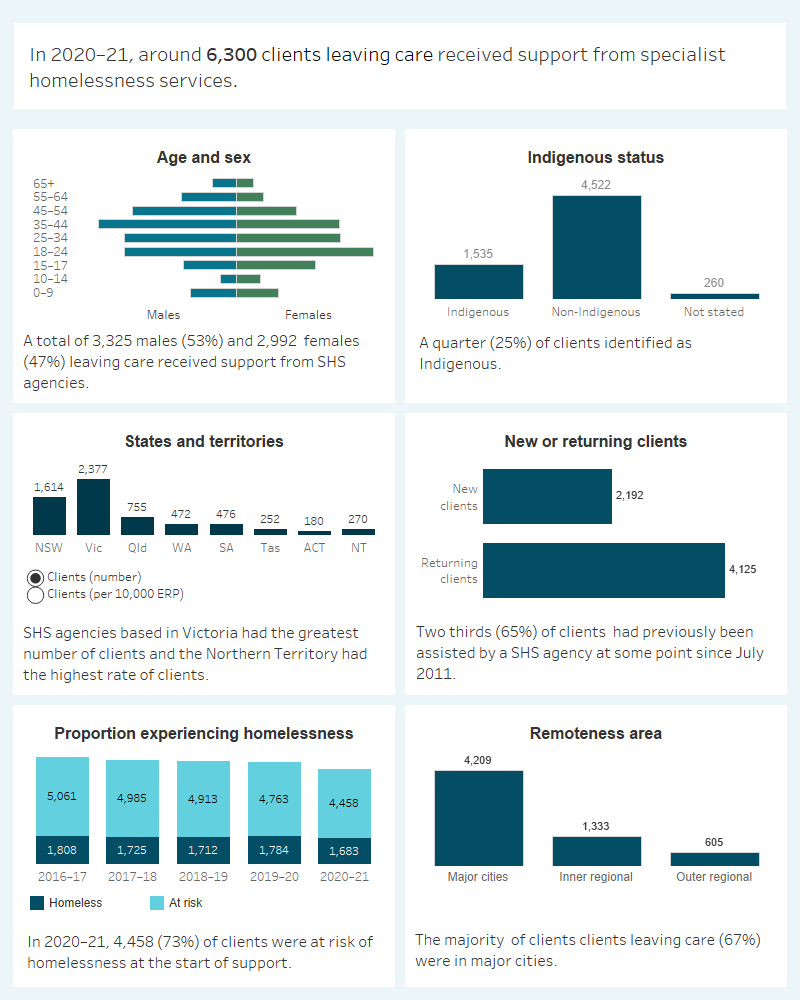
Dwelling type at beginning of support
In 2020–21, of the 6,300 SHS clients who were leaving care and stated their dwelling type at the beginning of support (Supplementary table LCARE.6):
- more than 1,700 clients (28%) were living in independent housing (house/townhouse/flat)
- nearly 1,200 (19%) were staying in a psychiatric hospital or unit
- around 1,000 (17%) were staying in a hospital (excluding psychiatric).
New or returning clients
In 2020–21, of the more than 6,300 SHS clients leaving care (Supplementary table CLIENTS.38):
- Around 35% (nearly 2,200 clients) were new to SHS services and 65% (more than 4,100 clients) were returning clients, having previously been assisted by a SHS agency at some point since the SHSC began in July 2011.
- Nearly half 50% (more than 650 clients) of the clients under 18 were returning clients while approximately 65% (around 820 clients) of clients who were aged 18–24 were returning clients. These age groups include young people who may have left foster care or other out-of-home care arrangements.
- The proportion of clients who had previously been assisted by SHS agencies was similar for males and females (almost 65% males, compared with around 66% females).
Selected vulnerabilities
Clients leaving care may face challenges that make them more vulnerable to experiencing homelessness, more specifically, family and domestic violence, a current mental health issue and problematic drug and/or alcohol use.
Figure LCARE.2: Clients leaving care, by selected vulnerability characteristics, 2020–21
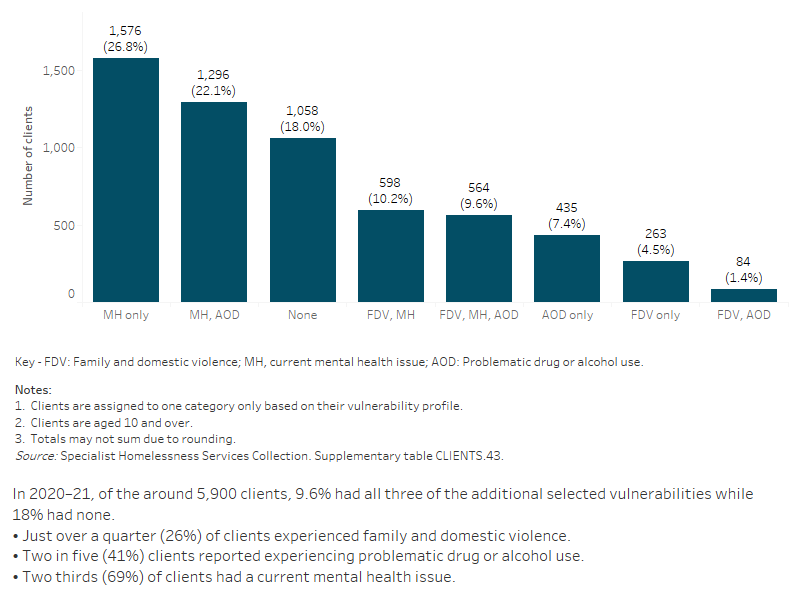
Service use patterns
The length of support clients leaving care received increased in 2020–21 to a median of 75 days, an increase from 62 days in 2016–17. The average number of support periods was 2.0 per client. The proportion of clients receiving accommodation was 45% for a median of 55 nights of accommodation (Supplementary table CLIENTS.44).
Main reasons for seeking assistance
In 2020–21, the main reasons for seeking assistance among clients leaving care were (Supplementary table LCARE.4):
- housing crisis (15% or more than 950 clients)
- transition from other care arrangements (13% or over 800 clients)
- inadequate or inappropriate dwelling conditions (11% or more than 700 clients).
Clients leaving care who were at risk of homelessness at first presentation were more likely to identify mental health issues (10% of those at risk, compared with 6.2% experiencing homelessness) and family and domestic violence (9.5%, compared with 5.8% experiencing homelessness) as their main reason for seeking assistance (Supplementary table LCARE.5).
Clients leaving care who were experiencing homelessness at first presentation were more likely to report transition from other care arrangements (19%, compared with 10% at risk) or transition from foster care and child safety residential placements (11%, compared with 4.5% at risk) as their main reason for seeking assistance.
Services needed and provided
Similar to the overall SHS population, clients leaving care needed general services which were provided by SHS agencies including advice/information, advocacy/liaison on behalf of client and other basic assistance.
Clients leaving care were more likely than all SHS clients to need services including (Supplementary tables LCARE.2, CLIENTS.23):
- living skills/personal development (33%, compared with 18%), with 91% receiving this service
- transport (25%, compared with 15%), with 91% receiving this service
- assistance with challenging social/behavioural problems (23%, compared with 12%), with 87% receiving this service
- mental health services (approximately 20%, compared with 8.9%), with 54% receiving this service and a further 18% referred
- health/medical services (19%, compared with 9.3%), with 59% receiving this service and a further 22% referred.
Figure LCARE.3: Clients leaving care, by services needed and provided, 2020–21
This interactive stacked horizontal bar graph shows the services needed by clients leaving care and their provision status. Short term accommodation was the most needed service and provided to the most clients. Long term housing was the least provided service.
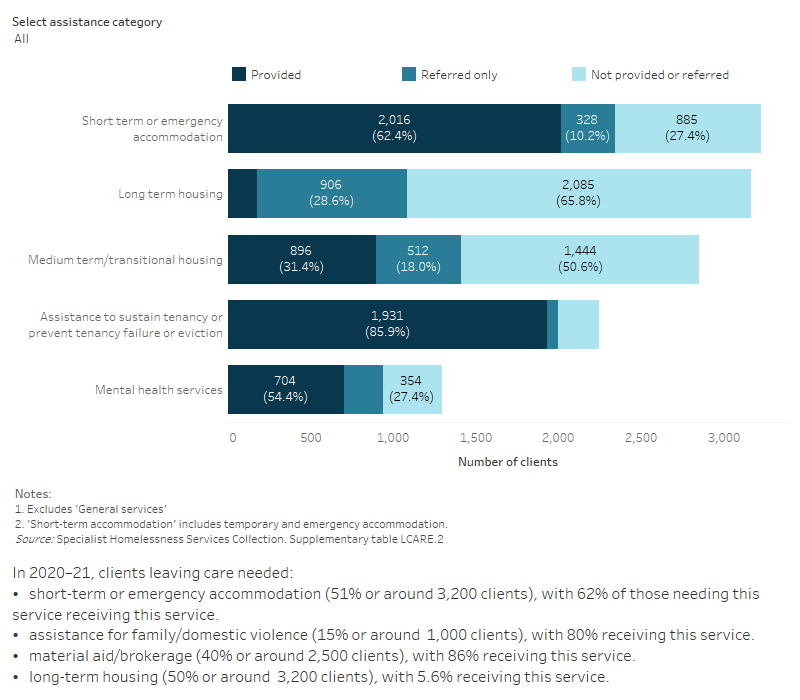
Housing situation and outcomes
Outcomes presented here describe the change in clients’ housing situation between the start and end of support. Data is limited to clients who ceased receiving support during the financial year – meaning that their support periods had closed and they did not have ongoing support at the end of the year.
Many clients had long periods of support or even multiple support periods during 2020–21. They may have had a number of changes in their housing situation over the course of their support. These changes within the year are not reflected in the data presented here, rather the client situation at the start of their first support period in 2020–21 is compared with the end of their last support period in 2020–21. A proportion of these clients may have sought assistance prior to 2020–21, and may again in the future.
By the end of support, some clients have achieved or progressed towards a more positive housing solution, however for some clients transitioning from institutional setting can be challenging. The most common housing situation for clients leaving care at both the beginning and end of SHS support was institutional settings; nearly 2,600 clients (62%) at the beginning and around 880 clients (24%) at the end of support. Institutional settings include hospitals, psychiatric hospital/units, rehabilitation and aged care facilities.
Outside of institutional settings, the number and/or proportion of clients housed in public or community housing (renter or rent-free) or private or other housing (renter or rent-free) increased compared with the start of support. For clients leaving care arrangements in 2020–21, around 1,000 clients (25%) were experiencing homelessness at the start of support; 600 (14%) were in short term temporary accommodation. By the end of support, 39% of clients were housed in either public, community, private or other housing, however 24% either remained in or transitioned into short term temporary accommodation (Figure LCARE.4).
Figure LCARE.4: Housing situation for clients leaving care with closed support, 2020–21
This interactive Sankey diagram shows the housing situation (including rough sleeping, couch surfing, short-term accommodation, public/community housing, private housing and institutional settings) of clients leaving care with closed support periods at first presentation and at the end of support. The diagram shows clients’ housing situation journey from start to end of support. Most started support in institutional settings. Most ended support in either institutional settings or private housing.
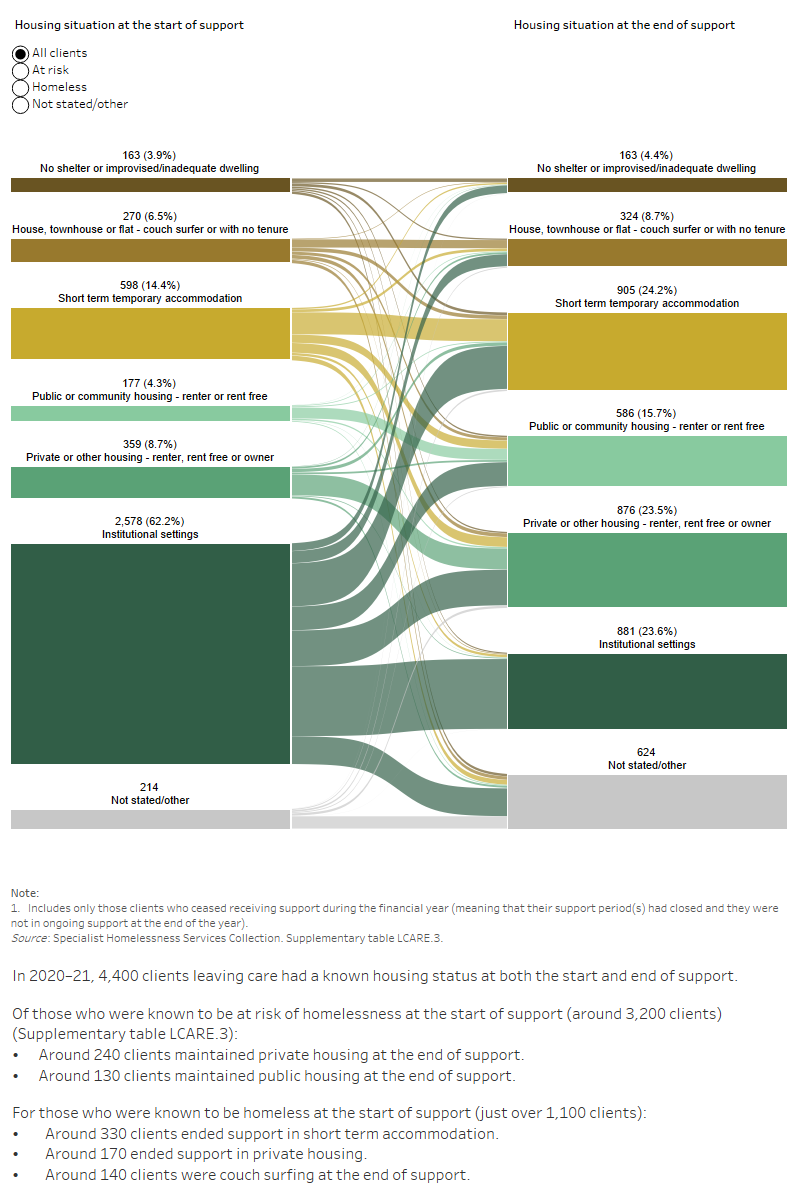
AIHW (Australian Institute of Health and Welfare) 2020. Child protection Australia 2018–19. Cat. no. CWS 74. Canberra: AIHW.
Brackertz N, Wilkinson A & Davison J 2018. Housing, homelessness and mental health: towards systems change. Melbourne: Australian Housing and Urban Research Institute.
CFFR (Council on Federal Financial Relations) 2018. National Housing and Homelessness Agreement. Viewed 7 August 2020.
FaHCSIA (Department of Families, Housing, Community Services and Indigenous Affairs) 2011. An outline of National Standards for out-of-home care: a priority project under the National Framework for Protecting Australia’s Children 2009–2020. Canberra: FaHCSIA.
McDowall JJ 2009. CREATE report card 2009 – Transitioning from care: tracking progress. Sydney: CREATE Foundation.
Nielssen OB, Stone W, Jones NM, Challis S, Nielssen A, Elliott G, Burns N, Rogoz A, Cooper LE & Large MM 2018. Characteristics of people attending psychiatric clinics in inner Sydney homeless hostels, The Medical Journal of Australia 208(4): 169-173.
Wilkins R, Laß I, Butterworth P & Vera-Toscano E 2019. The Household, Income and Labour Dynamics in Australia Survey: selected findings from waves 1 to 17. Melbourne: Melbourne Institute.
Wood L, Flatau P, Zaretzky K, Foster S, Vallesi S & Miscenko, D 2016. What are the health, social and economic benefits of providing public housing and support to formerly homeless people? AHURI Final Report No. 265. Melbourne: Australian Housing and Urban Research Institute Limited.


